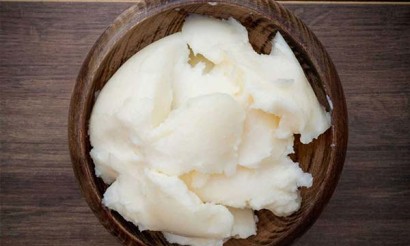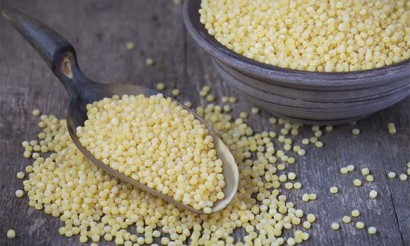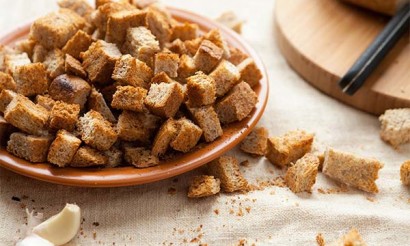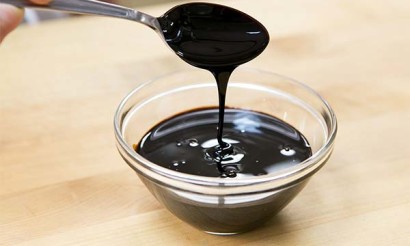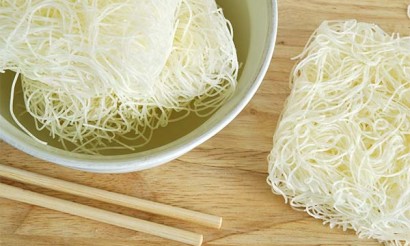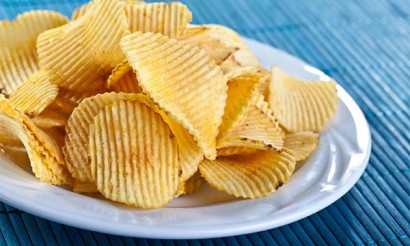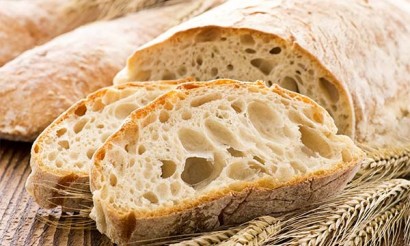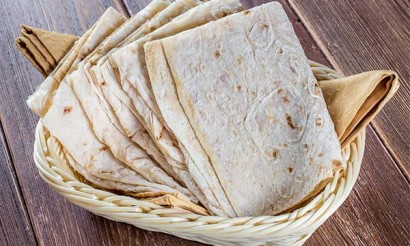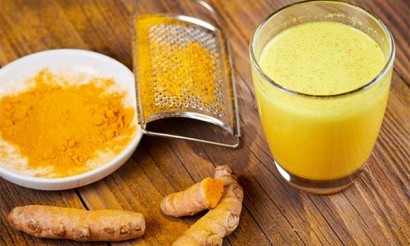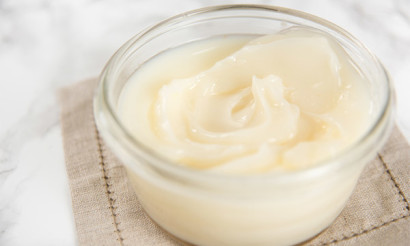The walls of walnuts: health properties and harms
Many people know about the benefits of walnuts. Indeed, their kernels contain many fatty acids and vitamins. But in fact, those people who buy already peeled walnuts, deprive themselves of the opportunity to use the useful substances that are contained in their septa. Even those who peel walnuts themselves, though, often consider the partitions to be garbage, and quite in vain. Their useful properties are proven by modern science.
- Composition and calories
- What are the walnut partitions useful for
- General benefits
- For Women
- For Men
- In pregnancy
- For breastfeeding
- For children
- For weight loss
- The walls of walnuts in medicine
- Recipes for application of the skulls
- The application of tincture of walnut capsules
- How to Make Tincture
- Cosmetic Applications
- For Face
- For Hair
- Harm and Contraindications
- Preparing and preserving the walnut skulls
- Do I have to wash walnut skulls?
- Interesting facts about walnuts
Composition and calories
Walnuts themselves are very caloric. Their energy value is 700 kcal per 100 grams. In this case, 400 grams of kernels, cleaned from the shell and membranes, is enough to satisfy completely the daily requirement in calories. However, they do not contain as much vegetable fat and protein (although they do contain a small amount of fatty acids, proteins, and sugars), so their caloric content is very low.
Peanut partitions contain many useful substances. These include tannins (there are none in the kernels themselves), coumarins, zinc, and even iodine. The complete list looks like this:
- Vitamin A, which is essential for normal vision, as well as improving skin health and rapid wound healing.
- B vitamins, which are responsible for normalizing metabolism and the functioning of the nervous system.
- Vitamin C, which improves blood vessels and increases the body's resistance to disease.
- Minerals - iron and potassium, magnesium and zinc, iodine and sodium.
- Phytosteroids - that is, the plant analog of hormones.
- Alkaloids and organic acids.
Tannins reduce the risk of infectious diseases, and they are also necessary for protein synthesis. Manganese and zinc have the ability to lower blood sugar levels. Vitamins A and C are antioxidants with anti-inflammatory properties.
What are the benefits of walnut partitions
General benefits
Aqueous infusions and decoctions from walnut septa are recommended for many diseases, including diabetes, thyroid disorders, atherosclerosis, hypertension, various inflammatory processes.
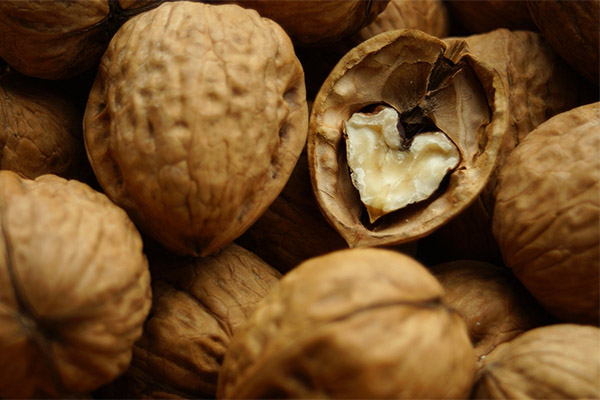
Most often the partitions of walnuts are not used in pure form, but prepared from them decoctions, infusions in water and alcohol. In this case, all three products have a fairly wide range of action, which allows you to fight a variety of pathologies.
Therapeutic remedies on the basis of walnut septa:
- Improve the functioning of the cardiovascular system.
- Help fight headaches and migraines.
- They are an effective remedy for diarrhea due to their constituent tannins, and their antiseptic properties make them useful for intestinal infections.
- They help to regulate the metabolism and thus contribute to weight loss.
- Eliminate the lack of iodine, which itself is the cause of many diseases.
- Improve cognitive function, normalize the activity of the central nervous system, which contributes to concentration.
- Allow to eliminate sleep disorders.
- Restore the body's resources after an acute respiratory infection or even pneumonia.
- Relieve pain in the joints at arthritis, as well as effective for osteochondrosis and other diseases of the musculoskeletal system.
Some adepts of folk medicine believe that funds based on the stem of walnuts are able to stop the growth of malignant tumors, but there is no scientific evidence of such an effect.
Tincture on the basis of this herbal raw material has a restorative effect. At the same time, the result of its use appears quite quickly. If you take an infusion or decoction on a constant basis, you will notice both an improvement in digestion and a decrease in the feeling of anxiety and nervousness. However, you should not expect miracles from this remedy. In the presence of chronic systemic diseases, it can be part of complex therapy, but not an independent medicine.
For women
The walls of walnuts have many useful properties, due to their chemical composition. The substances included in it help to normalize the hormonal balance, which is very important for many women, since problems with it can occur at very different periods of life - from the first menstruation to menopause. Stress, poor environmental conditions, pregnancy and childbirth can aggravate the situation.
Hormonal imbalances eventually lead to various gynecological diseases, such as myomas. And taking an infusion based on the walnut stalks allows you to normalize the hormonal balance and prevent the development of pathologies.
But even this remedy eliminates iodine deficiency in the body, which can lead to such an unpleasant phenomenon as mastopathy or even to serious violations of the thyroid gland. With iodine deficiency, there will always be a vicious circle associated with poor thyroid function, due to which not enough hormones are produced. Especially pronounced such a pathology is manifested during the menopause, while the use of products based on the husks of walnuts can avoid this.
However, it should be remembered that an overabundance of iodine in the body can also lead to the development of thyroid diseases. Therefore, first you need to make sure that there is a deficiency of this element. The best way to do this is to see a doctor and undergo a full examination. And at home you can do something like an express test. It is very simple - at night you need to smear the skin of the heels with an ordinary tincture of iodine, which is sold in pharmacies. If in the morning most of it remains on the skin, it's a good sign - it says that the iodine is poorly absorbed, and the body lacks it. If in the morning traces of iodine will be almost invisible - it means that there is a lack of it. Unfortunately, in most parts of Russia, with the exception of coastal areas, the lack of this element - a common occurrence.
For men
Representatives of the stronger sex also need iodine. With a lack of this element greatly increases the risk of adenoma and inflammatory prostate diseases. So the infusion of walnut stalks can be taken even for preventive purposes.
When pregnant
Many expectant mothers may have a deficiency of iodine in the body. Since walnut partitions contain this element in large quantities, they can help to cope with this problem. However, their decoction should be consumed in very small quantities.
You need to buy quality nuts, break the shell, remove the septa from it. 0.5 cup of such raw materials pour into an enameled saucepan, where then pour 0.4 l of cold water. Bring the product to a boil, for 10 minutes over low heat, then cool and filter it, using for this purpose gauze. The result is a decoction of a rather dark brown color, in color it should resemble strong tea. This decoction should be drunk three times a day before the main meals in a sip.
When breastfeeding
In the recovery period after childbirth, many women are faced with hormonal disorders and iodine deficiency, and iron deficiency anemia. Decoction of walnut stalks will help to cope with this problem. But you should understand that for all its positive properties, it can cause allergies. Therefore, for at least a month after childbirth is better not to risk. And after that you can take a little decoction, but first consult your doctor.
For children
Young children under the age of three years of decoction and infusion of walnut stalks is better not to give, because their digestive system is not yet mature. The use of this remedy can lead to chronic constipation, not to mention the possibility of developing an allergic reaction.
However, junior high school students can already be given decoction of walnut twigs - literally 3 teaspoonfuls per day, dividing them into three meals. This will help to cope with iodine deficiency or anemia. But you can do this only after consulting with your pediatrician.
When losing weight
By themselves, walnut partitions do not have fat-burning properties. But they allow you to normalize the hormonal balance and reduce blood sugar levels, which indirectly allows you to reduce the amount of fat tissue. In addition, the substances they contain - they are organic acids, alkaloids and glycosides - help speed up metabolic processes, which also contributes to weight loss.
Finally, the regular use of an infusion of walnut berry twigs helps normalize digestive processes, and after all good gastrointestinal function is the most important condition for weight loss.
For weight loss is recommended to take an aqueous infusion of the sepals of walnut. The remedy is taken by 3 tablespoons before each meal, with clean water without gas. You can add a little honey to improve the taste. The minimum course of intake is one month. During this time, even without a strict diet, you can lose up to 3 kg. And if you combine intake with active sports, it will be possible to lose up to 4-5 kg.
Walnut germs in medicine
There are different means on the basis of the walnut septa. The most common option is a tincture on vodka, which has many useful properties. It should be used for such diseases:
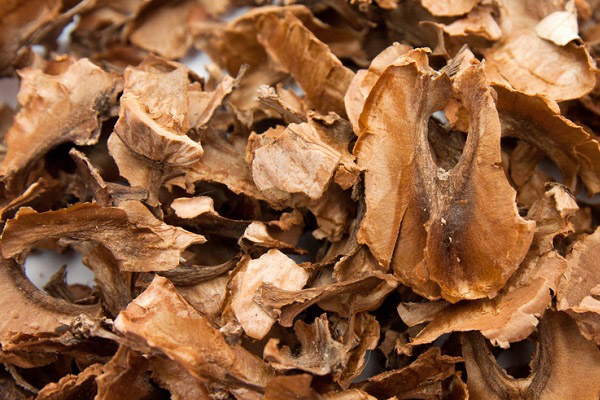
- Diabetes mellitus. The unique chemical composition of the bunches allows you to normalize blood sugar levels, but only if you use the remedy for a long time. The minimum duration of the course is one and a half months. During this time, it is recommended to drink 10 drops of the alcohol tincture dissolved in 1 tablespoon of cold boiled water daily on an empty stomach.
- Thyroid disease caused by a lack of iodine in the body. Walnut partitions can solve this problem as well. In this case, the minimum duration of treatment is 2 weeks. All this time the tincture is taken by ½ teaspoon twice a day before meals. After that, take a break for a month, and if necessary, then repeat the course.
- In joint diseases such as arthritis, arthrosis and rheumatism tincture is not taken internally, and is used as an external remedy. Use it 4-5 times a day to rub the problem areas. Another effective option is the use of tincture for compresses. Gauze is soaked with this remedy, attached to the painful joint, fixed with a polyethylene film and elastic bandage, and warmed with a woolen cloth on top. It is desirable to leave the compress for the whole night.
- In various colds, accompanied by coughing. Tincture on the basis of the walnut stalks drink 1 tsp. four times a day, not tied in time to the intake of food. Whenever the remedy is drunk with plenty of water.
- With diarrhea caused by various pathologies, the tincture is recommended to use as a mixture - 1.5 tbsp. three times a day until the situation is normalized. The tannins contained in the baffles have a fortifying effect.
The list of diseases in which walnut septa can be useful is quite wide. Below will be presented various recipes that will help to cope with such pathologies. From time to time, the tincture can be taken simply as a general tonic, but only if there are no contraindications to it, which will be discussed below.
Recipes for the use of berry twigs
There are many proven recipes for the use of walnut birch twigs. However, additional ingredients may be included in recipes for different ailments. For example:
- A solution for douches for candida and cervical erosion. It is made on the basis of 50 g of walnut skins and a cup of green walnut shells. Both ingredients have anti-inflammatory properties. Pour 500 ml of quality vodka and insist for three weeks, and then use it for douches, but be sure to dilute the remedy with water first (1/4 cup of tincture per liter of water). Undiluted tincture can cause burns of the mucous membranes. You can also add to this base an aqueous infusion of calendula or chamomile to enhance the anti-inflammatory properties of the remedy.
- Recipe for vascular cleansing. This remedy is sometimes in the literature called the Tibetan recipe, but in fact it does not contain any exotic components, all these are medicinal herbs, which are not difficult to find in the pharmacy. Take in equal proportions of crushed walnut partitions, dried flowers of chamomile, grass immortelle and St. John's wort, birch buds (for example, 50 g of each component). All ingredients are mixed and stored in a glass jar with a tight-fitting lid. Each day, prepare a fresh portion of the product. To do this, take 1 tbsp of the resulting mixture and brew 2 cups of boiling water. Insist for 4 hours. Before using it strain. A glass of cure is drunk 20-30 minutes before dinner, to improve the flavor there is added honey. In the morning, the remedy is heated a little and drunk for half an hour before breakfast. Such a remedy helps to prevent the appearance of cholesterol plaques.
- Tincture of walnut bark in diffuse toxic goiter. For 0.5 liters of quality vodka take 2 tablespoons of plant raw materials. The remedy is insisted in a dark place for two weeks, shaking occasionally. Before use it is filtered. Take three times a day, 1 tsp. spoon half an hour before the main meals.
- Alcoholic tincture for mastitis and hormone-dependent diseases. Take the partitions of 20-25 walnuts and insist in ½ cup of vodka or medical alcohol for 10 days. The product is taken within a month - this is the minimum course. The recommended dosage is 20 drops per ¼ cup of cold boiled water three times a day. If necessary, the course can be repeated after a break.
- Decoction. For the treatment of conjunctivitis of bacterial origin you can also use decoction of walnut stalks, ground to a powder (for example, such a grinding can be achieved in a good professional coffee grinder). For 100 grams of powder take 350 ml of cold water, bring the mixture to a boil, keep on low heat for 20 minutes, then pass it through a gauze folded in two layers. As a result, about 100 ml of dark brown liquid should remain. This decoction is soaked in gauze disks and put them on the eyelids for about 10 minutes, then wash your face in the usual way. For the treatment of allergic or viral conjunctivitis this remedy is not suitable, only for bacterial. The minimum duration of treatment is a week.
- Decoction for the treatment of the thyroid gland. If you are deficient in iodine, you can also take not an alcoholic tincture, but a decoction of walnut bracts. To do this, take 1 tbsp of vegetable raw materials in a glass of boiling water, bring the mixture to a boil, keep on the lowest heat for 10 minutes, strain and take three times a day, 1 tbsp. The minimum duration of the course is 10 days. After a two-week break, you can repeat the course twice more.
- Tincture for the treatment of the chronic form of colitis. To do this, take a glass of vodka for 2-3 tbsp. crushed berry twigs. The remedy is infused for a week. Take the tincture 6-10 drops three times a day, be sure to dilute it with water. But you can use this medicine only during the remission period, otherwise the inflammatory process will intensify.
- Tincture to improve the state of the brain vessels and against migraine. Take it at 5-6 drops per 1 tablespoon of water three times a day. The minimum course of treatment is one month.
- Tincture for intestinal diseases. For the treatment take the partitions of 25-30 walnuts for two glasses of vodka and insist for two weeks. Take 20 drops per tablespoon of water three times daily before meals.
Most supporters of phytotherapy believe that the main therapeutic effect of walnut stalks is associated with a high content of iodine. But in fact it is the result of the complex action of all its constituent substances. So, in addition to iodine, walnut skulls contain amino acids, including tyrosine, which is necessary for the thyroid. And the strong odor of iodine is partly due to the presence of another substance, juglone, which has a slightly different nature.
Tincture of walnut husks
Such a tincture has anti-inflammatory, antiseptic and bactericidal properties. But you need to understand that it does not replace antibiotic therapy, but only supplements it, that is, enhances the effect of medicines and makes them more effective.
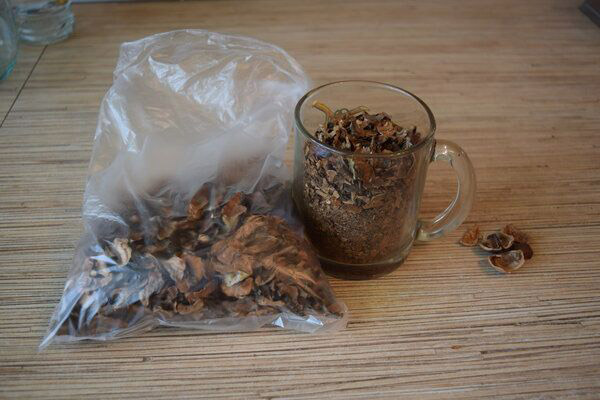
At the same time, the alcoholic tincture is used with caution. As a rule, start with a small dosage, then for some time to use the maximum, then gradually reduce, and after 2-4 weeks be sure to make a break to avoid side effects. That the treatment is working, the patient learns by the change of health - he has no symptoms of the disease. For example, he no longer suffers from dry mouth if he has diabetes.
It is also necessary to understand that it is impossible to completely cure a number of systemic diseases, including diabetes, some forms of mastopathy, spinal pathologies, even with the help of this tincture. It only alleviates the course of the disease and slows the pace of its development. But in most cases, this is enough to ensure an acceptable quality of life of the patient.
How to make a tincture
In the classic version of the tincture from walnut septa is made in the following way. Take a suitably sized container and fill it with about a third of previously prepared walnut partitions. They do not need to be crammed in; there should be an air space between the pieces, and then the liquid will be able to pass through freely, extracting the maximum amount of nutrients from the raw material. To ensure such conditions, the container is shaken.
The baffles are poured with quality vodka, so that it completely filled the container, almost up to the neck. Then the resulting product is insisted in a dark and dry place for 10-14 days, periodically shaking the container. After that, the tincture is filtered through the folded gauze folded in half and poured into bottles for storage.
Use it with caution. Depending on the particular problem, the dosage is about 7-15 drops, and they must be diluted with water.
Cosmetic use
A high content of useful substances allows the application of walnut septa in cosmetology. In the perfume industry, they are usually ground into powder, which is then used to produce scrubs. At home they can also be ground in a coffee grinder and used for the same purpose. But since the powder is not always that fine, it is best used to make a body scrub rather than for delicate facial skin. This ingredient is added to regular shower gel to get the desired effect.
For the face
In home cosmetology, the anti-inflammatory properties of the walnut's septa are mainly used. For example:
- Tincture for the treatment of acne. To do this, take the tincture described above - no more than 1 tbsp. and dissolve in a glass of hot water. From this agent make compresses that have antiseptic and anti-inflammatory effects. If desired, you can add 2 drops of tea tree essential oil to increase the effectiveness. The compress is held for 10 minutes, then change to the next, and so repeat four times. The treatment can be performed daily, and when the condition of the skin improves, it can be done every other day. After the compress it is recommended to apply a moisturizing cream for problematic and sensitive skin.
- Infusion to combat vitiligo. Its action is based on the fact that the substances contained in the infusion, for a while make the depigmented skin darker. Take 0.5 cup of walnut bracts, ground into powder, as many walnut leaves and pour vodka so that it completely covered the plant material. The remedy is infused for 10-12 days. Strain it is not necessary, the face applied directly to the infusion with the mush from the capsules. Such application is made in the morning and evening. The course of treatment is at least two months. It is necessary to apply the mush only on the affected areas.
But still walnut bark is most often used not to improve the skin of the face, but to solve other problems - for example, to remove plaque caused by the use of coffee and tea, as well as the elimination of hyperhidrosis (increased sweating). However, in the latter case, the infusion can also be used for the skin of the face - it impregnates sponges and makes lotions on the most problematic areas.
For hair
Since the partitions of walnuts contain many useful substances, they can be used to improve the condition of the hair. For example:
- Lotion for all types of hair. Prepare it from the raw material, which is poured into a mixture of vodka and boiled water, taken in equal proportions. For 120 grams of walnut leaflets (about half a glass) take so much liquid, that it completely covers the raw material. Pour the lotion into a container, preferably of dark glass, and put it in a kitchen cabinet or drawer so that it is not exposed to the sunlight. Insist for 10 days. Every day you must take out the container and shake it. When the lotion is ready, filter it through gauze and pour into another container. Then essential oils are added, such as geranium and eucalyptus, but you can also take any citrus oil for a pleasant smell. These ingredients are added in very small quantities, 2 drops each. The lotion is applied once a week. Apply it to a tampon and wet your scalp and hair roots with it. This procedure should be performed before washing your hair. After applying the means cover the head with plastic wrap, warm it with a terry towel and hold for 15 minutes, and then wash it off with shampoo.
- Infusion for dry hair. Prepare it this way - mix 50 ml of vodka and 50 grams of walnut bark. The remedy is insisted for two weeks, leaving it in a dry and dark place, but shaking periodically. Then strain the setting, add 1 tsp. liquid flower honey, and 2-3 drops of essential oil of rose (or rosewood - it also has moisturizing properties). The product is rubbed not only on the scalp, but also distributed along the entire length of the hair. Then wear a plastic shower cap and a terry towel on top. Hold the composition for half an hour, then you can wash it off in the usual way.
Important: you need to understand that regular use of these lotions will not only make the hair thicker, but also give it a darker shade.
Harms and contraindications
Although all remedies on the basis of walnut bunches are available and quite effective, they should be used only after prior consultation with a doctor and on the condition that there are no contraindications against them, which include:
- Allergies to nuts, including manifested by hives.
- Skin diseases - psoriasis, eczema.
- Gastritis with high acidity, as well as acute forms of inflammatory diseases like pancreatitis and colitis.
In addition, these remedies are used with caution in irritable bowel syndrome and constipation, because the substances contained in the sepals can aggravate the situation.
Harvesting and storage of walnut twigs
In order to get quality septa, you need to first choose good nuts. And to do this, you will have to carefully inspect each of them when buying them. Usually raw walnuts are sold only at the market, in supermarkets only ready and packed in polyethylene kernels already get. At the market the buyer has an opportunity to look closely at all the shells and make sure they have no holes, cracks or other visible damage. This can lead to mold growth in nuts and then neither kernels nor baffles can be used for medicinal purposes.
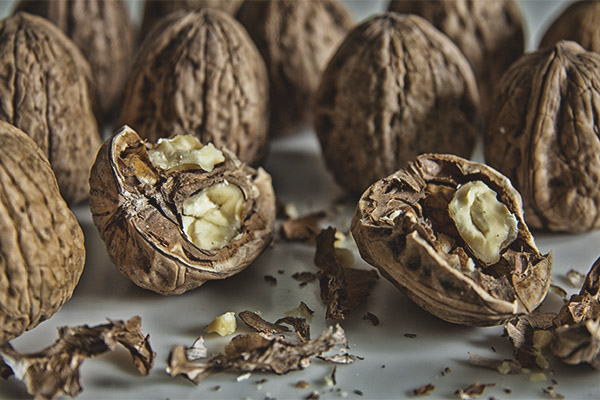
Each nut should be weighed in your hand to make sure it is heavy enough. When shaking it, it should not make any sounds (if it seems that something is rolling around inside, it means that both the kernel and the septa have dried out and partially lost their useful properties).
It is desirable to check not only the nuts themselves, but also the container in which they are stored before sale. It is enough just to put your hand in there and see if there is moisture. By the way, the wet shells are a good reason not to buy nuts, because most likely the kernels and membranes have already gone bad.
Some companies sell packed partitions of walnuts. In this case, you should carefully examine the package to see the expiration date and make sure that the integrity of the package has not been violated. On average, walnut barnacles retain their useful properties for six months.
If the barnacles were collected at home, it is best to store them in a cloth bag or paper container, in the extreme case - in a ceramic jar with a tightly closed lid. The container should be opaque, because direct sunlight can destroy the partitions and promote oxidation processes. You can also store them at room temperature, the main thing is not to keep them near the stove, where the air is hot and humid.
It is also very important to maintain normal humidity. This also applies when storing whole nuts. When humidity is high, the tannins contained in the partitions will transfer to the kernels. As a result, the nuts become bitter, and the baffles partially lose their useful properties.
It is important to avoid contact with the air, which also stimulates oxidation processes - to which the partitions are exposed, and since they contain fatty acids, they can go rancid if stored incorrectly.
Should walnut baffles be washed?
If the partitions were taken out of whole nuts at home, in principle it is not necessary to wash them, especially since they are poured with alcohol or boiling water to prepare infusions. But it is better to wash the nuts themselves, so that no dirt or infection gets inside. The shells are washed with ordinary soap, which is used in the kitchen, or (alternatively) scalded with boiling water.
Some housewives recommend holding the raw nuts for a couple of minutes in a weak baking soda solution. Whichever way you eventually decide to use, the nuts should be thoroughly dried after washing, leaving them for a couple of days on a paper or cloth towel so that no sunlight falls on them.
Interesting facts about walnuts
The walnut is one of the oldest crops known to mankind. It is believed that it has been present in the human diet for over 8 thousand years. However, contrary to popular misconception, it did not originate in Greece - it was brought there from Central Asia. And archaeologists have found ancient Mesopotamian tablets with texts stating that these nuts grew in the gardens of ancient Babylon. By the way, in ancient Greece, this nut was called the acorn of the gods, and under this name it was also known to the Romans.
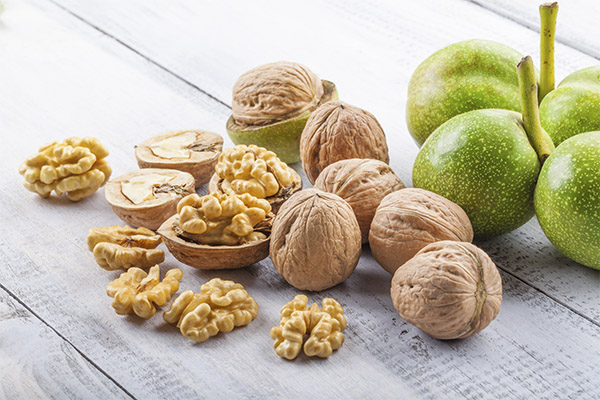
In ancient times, walnuts were grown on the territory of Wallachia, in those days this province belonged to Rome (today it is part of Romania). On the territory of Kievan Rus, and later the Moscow Kingdom, walnuts were brought by Greek and Walachian merchants. Hence the Russian name "walnut" and the Ukrainian "woloky gorikh".
Nature made sure that the walnut was packed securely. To get the walls out of it, you first need to peel it. But it has two protective layers - a dense green shell and a very thick shell. As a rule, even in bazaars, nuts are sold already peeled from the upper shell (although it itself is also very useful).
Even if the hostess is not planning to make an infusion of walnut pods, it is better to buy walnuts not yet peeled. The fact is that, left without the shell, the kernels begin to oxidize and lose their original taste. So it is better to store them not peeled, breaking the shells only in those nuts, which will be used now - for example, for baking or dessert. Just as you can get the partitions out.
Cracking the shells is not as easy as it might seem. However, relatively recently walnuts with thinner shells have been bred, which can literally be crushed by squeezing two such fruits in the fist. But in this case the inner partitions are also thin, and it will be difficult to separate them from the kernels. In Central Asia, for such varieties of nuts have their own tricks - the kernels directly together with the partitions are mixed with flour, and then lightly roasted in a frying pan without oil. After the mass is gently kneaded with hands, the partitions come off. But it is not recommended to make a classic tincture out of them afterwards, because they lose some of their useful substances during such processing. But their kernels have a more subtle and delicate taste.
Although walnuts are tasty and nutritious, and their septa are useful, in fact with them should always be observed in moderation and caution. The oil contained in all parts of the walnut oxidizes quickly. This not only affects its taste, but also leads to the development of inflammation in the mouth and tonsils. This is why it is recommended to rinse the mouth with water after consuming nuts, and to use the tincture in a highly diluted form.
«Important: All information on this site is provided solely for educational purposes purposes. Consult with your health care professional before applying any recommendations. specialist before using the recommendations. Neither the editors nor the authors shall be liable for any possible harm caused by materials."

